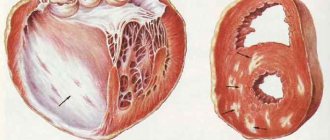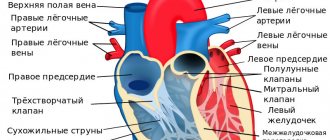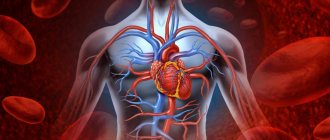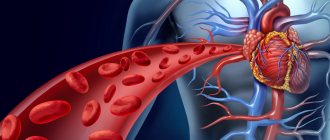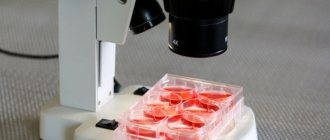What are monocytes and how are they formed?
Monocytes are a type of agranulocytic leukocyte (white blood cell). This is the largest element of the peripheral blood flow - its diameter is 18-20 microns. The oval-shaped cell contains one eccentrically located polymorphic bean-shaped nucleus. Intense staining of the nucleus makes it possible to distinguish a monocyte from a lymphocyte, which is extremely important in the laboratory assessment of blood parameters.
In a healthy body, monocytes make up 3 to 11% of all white blood cells. These elements are also found in large quantities in other tissues:
- liver;
- spleen;
- Bone marrow;
- The lymph nodes.
Monocytes are synthesized in the bone marrow, where their growth and development are influenced by the following substances:
- Glucocorticosteroids inhibit the production of monocytes.
- Cell growth factors (GM-CSF and M-CSF) activate the development of monocytes.
From the bone marrow, monocytes penetrate into the bloodstream, where they remain for 2-3 days. After a specified period, the cells either die through traditional apoptosis (cell death programmed by nature), or move to a new level - they turn into macrophages. The improved cells leave the bloodstream and enter the tissues, where they remain for 1-2 months.
What are monocytes in the human body and what are they responsible for?
Monocytes enter the peripheral blood and remain in it for 40–72 hours. They then migrate to organs and tissues for further maturation, where they are transformed into tissue macrophages.
To understand in what cases an increase or decrease in monocytes is observed, and whether this is a pathology, you need to understand what monocytes are and what function they perform.
A combination of monocytes and macrophages with reticular and endothelial cells form the reticuloendothelial system. This system carries out barrier, phagocytic and metabolic functions.
Depending on where macrophages are located, they acquire certain properties. The following types of such cells are distinguished:
- Kupffer's, formed as a result of the migration of macrophages to the liver;
- littoral, located in the lymph nodes and spleen;
- bone marrow;
- microglial, lining nervous tissue;
- peritoneal, located in pathological exudate (fluid entering the tissue when the permeability of the vascular wall increases);
- alveolar, located in lung tissue;
- osteoclasts, located in the bones;
- histiocytes are connective tissue cells.
First of all, you need to understand what monocytes are responsible for and what their content in the blood depends on. The main function of these cells is protective. They participate in the process of phagocytosis (intracellular digestion). First, the phagocyte purposefully moves towards the virus, bacteria or damaged cell.
Blood cells - monocytes
Then adhesion (sticking) of the foreign agent occurs on the surface of the macrophage. This is accomplished due to special receptors located on the phagocyte or through nonspecific adsorption (absorption). After this, special lysosomal enzymes are activated, which neutralize or destroy the pathogenic microorganism located inside the macrophage.
Monocytes take part in the formation of the immune response. Macrophages recognize a foreign antigen that has entered the body and absorb it. This antigen is then cleaved by lysosomes located in the cytoplasm of monocytes. Fragments of the split antigen form a special complex that releases special substances (interleukins). As a result, T and B lymphocytes are activated and antibodies specific to these antigens are formed.
Answering the question of what monocytes are in a blood test, it should be said that they are the only cells that produce tissue thromboplastin. This is one of the blood clotting factors that helps stop bleeding.
An equally important function of macrophages is their ability to secrete active substances: prostaglandins, pyrogens, lysozyme, properdin, interferon. Thus, they participate in antibacterial and antiviral defense, regulate cellular and humoral immunity.
Monocytes and macrophages: what is the difference?
In the 70s of the last century, it was believed that all monocytes sooner or later turn into macrophages, and there are no other sources of “professional janitors” in the tissues of the human body. In 2008 and later, new studies were conducted that showed that macrophages are heterogeneous. Some of them actually originate from monocytes, while others arise from other progenitor cells even at the stage of intrauterine development.
The transformation of some cells into others follows a programmed pattern. Coming out of the bloodstream into the tissue, monocytes begin to grow, and the content of internal structures - mitochondria and lysosomes - increases. Such rearrangements allow monocyte macrophages to perform their functions as efficiently as possible.
Biological role of monocytes
Monocytes are the largest phagocytes in our body. They perform the following functions in the body:
- Phagocytosis. Monocytes and macrophages have the ability to recognize and capture (absorb, phagocytose) foreign elements, including dangerous proteins, viruses, and bacteria.
- Participation in the formation of specific immunity and protection of the body from dangerous bacteria, viruses, fungi through the production of cytotoxins, interferon and other substances.
- Participation in the development of allergic reactions. Monocytes synthesize some elements of the complement system, due to which antigens (foreign proteins) are recognized.
- Antitumor protection (provided by the synthesis of tumor necrosis factor and other mechanisms).
- Participation in the regulation of hematopoiesis and blood clotting due to the production of certain substances.
Monocytes, along with neutrophils, belong to professional phagocytes, but have distinctive features:
- Only monocytes and their special form (macrophages) do not die immediately after absorbing a foreign agent, but continue to perform their immediate task. Losing a fight against dangerous substances is extremely rare.
- Monocytes live much longer than neutrophils.
- Monocytes are more effective against viruses, while neutrophils deal mainly with bacteria.
- Due to the fact that monocytes are not destroyed after a collision with foreign substances, pus does not form in places where they accumulate.
- Monocytes and macrophages are capable of accumulating in areas of chronic inflammation.
Why are eosinophils and monocytes needed?
Let's talk a little about eosinophils and monocytes. They, of course, perform different functions, and when their numbers are increased, it is necessary to find out which subpopulation is increased the most. And the most important thing is whether this increase is related to each other, or whether the patient is experiencing two independent pathological processes. The doctor, when he interprets the analysis, must understand that any changes in the leukocyte formula do not clearly indicate any disease, that is, they do not have specificity.
They can be caused by a variety of diseases, and the blood can react with different populations of cells in the same way. On the other hand, with the same disease in different patients, the blood can react in different ways.
It should not be forgotten that the assessment of a subpopulation of leukocytes has certain characteristics. The age of the patient must be taken into account. It is very important to remember that any deviation can be absolute or relative. With an absolute deviation, the number of monocytes and eosinophils increases, since more of them are simply actually produced. If this deviation is relative, then in reality there are exactly the same number of them, but in a given blood sample there are more of them, since there are fewer of them elsewhere. Therefore, in order to get a complete picture of the real number of leukocyte subpopulations, it is necessary to know not only their number per liter, but also as a percentage.
Monocytes
Monocytes in a typical blood smear always look like large cells, their nucleus resembles a bean or legume, without any constrictions and without segments. Monocytes do not live long in the blood, no more than a day, and then the pool of released monocytes rushes into the tissue. It enters the tissue through the endothelium, or the inner wall of capillary vessels, through active movement. In the tissue, the monocyte turns into special cells - macrophages, and are forever lost from the systemic circulation. They live in tissues for a very long time, up to several years, which is several times longer than the lifespan of any blood cells in blood vessels.
Tissue macrophages are active defenders, and in tissues they do the same thing as neutrophils in blood plasma. They recognize, capture and destroy all foreign microorganisms, including fungi; tissue macrophages have a high degree of phagocytosis. They actively appear in foci of tissue inflammation, where they also destroy all microbes, damaged cells, as well as their dead brothers - leukocytes. Macrophages are the most active cells capable of phagocytosis in our body, and their task in the area of inflammation is complete cleansing, elimination of the pathogen, destruction of tissue detritus and pus and preparation of the area for restoration or tissue regeneration. However, monocytes can not only be beneficial, but sometimes they also support pathological, autoimmune inflammation, such as in rheumatoid arthritis.
Therefore, the number of monocytes in the blood is the tip of the iceberg, a huge part of them is in the tissues, and therefore it is, of course, impossible to judge the state of macrophages by the monocytes that are in the bloodstream.
Read more about monocytes in our article Monocytes in the blood: functions, normal, causes of abnormalities.
Eosinophils
Eosinophils are cells of which there are very few in the blood, fewer of them, perhaps, only basophils. Yes, eosinophils are also capable of phagocytosis, but still their role is different. They are particularly good at recognizing parasitic antigens and engaging in various allergic cellular reactions.
Not a single neutrophil can compare with eosinophils in their ability to recognize and bind antigens of multicellular parasites. These primarily include various flatworms, roundworms and tapeworms. These are pinworms and roundworms, the cat fluke - the causative agent of opisthorchiasis and the liver fluke, the causative agents of diphyllobothriasis and taeniasis, that is, the broad tapeworm, and the pork tapeworm. These cells also remain in the blood for a very short period of time, literally a few hours, and then are transported to the tissues in order to restore order there, just like monocytes.
For more complete information, read the articles - Eosinophils: age norm and causes of deviations and Eosinophilia in adults.
Determination of the level of monocytes in the blood
The total number of monocytes is displayed as part of the leukocyte formula and is included in the complete blood count (CBC). The material for research is taken from a finger or from a vein. Blood cell counting is carried out manually by a laboratory assistant or using special devices. The results are issued on a form, which must indicate the standards adopted for a particular laboratory. Different approaches to determining the number of monocytes can lead to discrepancies, so it is imperative to take into account where and how the analysis was taken, as well as how the blood cells were counted.
Functions of monocytes
The bone marrow is responsible for their production. After maturation, their location becomes the peripheral bloodstream for a period of 36 to 104 hours. These cells achieve their greatest activity during the period when they are in the bloodstream. These are the largest blood cells related to leukocytes. There are no granules in their cytoplasm, and they are considered the most active phagocytes (that is, they exhibit the ability to absorb pathogenic microorganisms and protect humans from their influence). Monocytes actively protect the human body, fight infectious diseases, destroy blood clots, preventing thrombus formation, and also show activity against tumors of various etiologies.
What other functions do monocytes have in the blood?
Normal value of monocytes in children and adults
During hardware decoding, monocytes are designated MON; during manual decoding, their name does not change. The norm of monocytes depending on the age of a person is presented in the table:
| Age | Norm of monocytes, % |
| 1-15 days | 5-15 |
| 15 days – 1 year | 4-10 |
| 1-2 years | 3-10 |
| 2-15 years | 3-9 |
| Over 15 years old | 3-11 |
The normal value of monocytes does not differ between women and men. The level of these blood cells does not depend on gender. In women, the number of monocytes increases slightly during pregnancy, but remains within the physiological norm.
In clinical practice, not only the percentage, but also the absolute content of monocytes per liter of blood matters. The norm for adults and children is as follows:
- Up to 12 years – 0.05-1.1*109/l.
- After 12 years – 0.04-0.08*109/l.
How to reduce
If monocytes are elevated, this fact should not be ignored. Even small deviations may indicate the presence of inflammatory, viral or infectious diseases. The sooner you contact a specialist, the easier it is to get rid of leukocytosis. However, the range of diseases accompanied by a high level of leukocytes in the blood is so wide that many people do not know which specialist to contact.
If the analysis shows an increased content of white blood cells, then first of all you should contact a therapist, who will definitely prescribe a repeat analysis in order to exclude an error.
If there is no error, then, depending on other symptoms that the therapist must also identify during the medical history, additional tests will be prescribed, and only after that a diagnosis is made and a specialist is identified who will treat the patient.
The therapist treats flu or ARVI himself. The patient is prescribed a course of antibiotics, vitamins, as well as drugs aimed at symptomatic treatment.
If the patient is diagnosed with simple helminths (for example, roundworms), the therapist will select a treatment regimen and, depending on the type of parasite, will prescribe tablets. In severe cases of helminization (for example, when infected with bovine tapeworm), the help of an infectious disease specialist and gastroenterologist will be required.
The help of an infectious disease specialist is necessary when infected with measles, chickenpox, dysentery, brucellosis and other infectious diseases. In this case, the patient must be hospitalized and, depending on the disease, he is prescribed a complex treatment regimen.
Important information: Lifespan of leukocytes in human blood
If a therapeutic examination reveals aggravated gastrointestinal diseases (gastritis, enteritis, ulcers, etc.), then a gastroenterologist will treat the patient. The goal of treatment is to achieve remission of the disease, for which the patient will be prescribed immunomodulators, corticosteroids, and aminosalicylates. After a course of medications, a control test is given. Normalization of the level of all types of leukocytes will mean that remission has occurred.
Patients with syphilis must undergo treatment at a skin and venous dispensary, where they will be prescribed a course of antibiotics and restorative drugs.
The most severe cases are associated with the development of malignant neoplasms, which will be dealt with by an oncologist. The doctor will conduct an examination, identify the stage of the disease, the location of the tumor, the extent of its spread, depending on which the patient will be offered courses of chemotherapy, radiation therapy or surgery. Treatment regimens are individual in nature, since many factors have to be taken into account. The goal of treatment is to prevent the tumor from spreading to other organs.
If the absolute content of monocytes in the blood is increased as a result of a stressful situation, then you should consult a psychologist, or in more severe cases, a psychotherapist. In such situations, monocytes are brought back to normal by means of stabilizing the patient’s psycho-emotional state, in conjunction with psychotherapy sessions.
Regardless of the reason for the increase in the level of white blood cells, the complex of therapeutic measures aimed at lowering them must include proper nutrition. It is necessary to give up sugar and alcohol, and introduce more fish and seafood rich in omega acids into the diet. In addition, you should eat more vegetables, fruits, nuts and whole grains, which effectively fight inflammation, which causes an increase in monocyte levels.
Reasons for the increase in monocytes in the blood
An increase in monocytes above the threshold value for each age group is called monocytosis. There are two forms of this condition:
- Absolute monocytosis is a phenomenon when there is an isolated growth of monocytes in the blood, and their concentration exceeds 0.8*109/l for adults and 1.1*109/l for children under 12 years of age. A similar condition is recorded in some diseases that provoke the specific production of professional phagocytes.
- Relative monocytosis is a phenomenon in which the absolute number of monocytes remains within normal limits, but their percentage in the bloodstream increases. This condition occurs when the level of other white blood cells decreases simultaneously.
In practice, absolute monocytosis is a more alarming sign, since it usually indicates serious problems in the body of an adult or child. The relative increase in monocytes is often transient.
What does an excess of monocytes indicate? First of all, it means that phagocytosis reactions have started in the body, and there is an active fight against foreign invaders. The following conditions can cause monocytosis:
Physiological causes of monocytosis
In all healthy people, monocytes increase slightly in the first two hours after eating. It is for this reason that doctors recommend donating blood exclusively in the morning and on an empty stomach. Until recently, this was not a strict rule, and a general blood test with determination of the leukocyte formula was allowed to be done at any time of the day. Indeed, the increase in monocytes after a meal is not so significant and usually does not exceed the upper threshold, but the risk of incorrect interpretation of the result still remains. With the introduction into practice of devices for automatic decoding of blood, sensitive to the slightest changes in cellular composition, the rules for taking the test were revised. Today, doctors of all specialties insist that the OAC be taken on an empty stomach in the morning.
High monocytes in women occur in some special situations:
Menstruation
In the first days of the cycle, healthy women experience a slight increase in the concentration of monocytes in the blood and macrophages in the tissues. This is explained quite simply - it is during this period that active rejection of the endometrium occurs, and “professional janitors” rush to the hearth to perform their immediate duties. The growth of monocytes is observed at the peak of menstruation, that is, on the days of the most heavy discharge. After the monthly bleeding is completed, the level of phagocyte cells returns to normal.
Important! Although the number of monocytes during menstruation usually does not go beyond the normal range, doctors do not recommend taking a complete blood count until the end of your monthly discharge.
Pregnancy
The restructuring of the immune system during pregnancy leads to low levels of monocytes in the first trimester, but then the picture changes. The maximum concentration of blood cells is recorded in the third trimester and before birth. The number of monocytes usually does not exceed the age norm.
Pathological causes of monocytosis
Conditions in which monocytes are so elevated that they are determined in a general blood test to be outside the normal range are considered pathological and require mandatory consultation with a doctor.
Acute infectious diseases
The growth of professional phagocytes is observed in various infectious diseases. In a general blood test, the relative number of monocytes in ARVI slightly exceeds the threshold values accepted for each age. But if during a bacterial infection there is an increase in neutrophils, then in the event of a viral attack, monocytes enter the battle. A high concentration of these blood elements is recorded from the first days of illness and persists until complete recovery.
- After all symptoms subside, monocytes remain high for another 2-4 weeks.
- If an elevated monocyte count is recorded for 6-8 weeks or more, a source of chronic infection should be sought.
With a common respiratory infection (cold), the level of monocytes increases slightly and is usually at the upper limit of normal or slightly beyond its limits (0.09-1.5 * 109/l). A sharp increase in monocytes (up to 30-50*109/l or more) is observed in oncohematological diseases.
An increase in monocytes in a child is most often associated with the following infectious processes:
Infectious mononucleosis
The disease caused by the herpes-like Epstein-Barr virus occurs primarily in preschool children. The prevalence of the infection is such that almost everyone gets it by adolescence. It almost never occurs in adults due to the peculiarities of the immune system's response.
Symptoms:
- Acute onset with fever up to 38-40 °C, chills.
- Signs of upper respiratory tract damage: runny nose, nasal congestion, sore throat.
- Almost painless enlargement of the occipital and submandibular lymph nodes.
- Skin rash.
- Enlarged liver and spleen.
Fever during infectious mononucleosis persists for a long time, up to a month (with periods of improvement), which distinguishes this pathology from other acute respiratory viral infections. In the general blood test, both monocytes and lymphocytes are elevated. The diagnosis is made based on the typical clinical picture, but a test for specific antibodies may be performed. Therapy is aimed at relieving the symptoms of the disease. Targeted antiviral treatment is not carried out.
Other childhood infections
The simultaneous growth of monocytes and lymphocytes is observed in many infectious diseases that occur mainly in childhood and are almost not detected in adults:
- measles;
- rubella;
- whooping cough;
- mumps, etc.
In these diseases, monocytosis is observed in the case of protracted pathology.
In adults, other causes of an increase in the number of monocytes in the blood are identified:
Tuberculosis
A severe infectious disease that affects the lungs, bones, genitourinary organs, and skin. You can suspect the presence of this pathology based on certain signs:
- Long-lasting causeless fever.
- Unmotivated weight loss.
- Prolonged cough (with pulmonary tuberculosis).
- Lethargy, apathy, increased fatigue.
Annual fluorography helps identify pulmonary tuberculosis in adults (in children, the Mantoux test). A chest x-ray helps confirm the diagnosis. To detect tuberculosis of other localizations, specific studies are carried out. In the blood, in addition to an increase in the level of monocytes, there is a decrease in leukocytes, erythrocytes and hemoglobin.
Other infections can lead to monocytosis in adults:
- brucellosis;
- syphilis;
- sarcoidosis;
- cytomegalovirus infection;
- typhoid fever, etc.
The growth of monocytes is observed during a prolonged course of the disease.
Parasitic infestation
Activation of monocytes in the peripheral blood is observed during helminth infection. These can be either opisthorchid, bovine or pork tapeworm, pinworms and roundworms, which are common in temperate climates, or exotic parasites. When the intestines are damaged, the following symptoms occur:
- Abdominal pain of various localizations.
- Loss of stool (usually diarrhea).
- Unmotivated weight loss due to increased appetite.
- Allergic skin reaction such as urticaria.
Along with monocytes, an increase in eosinophils, granulocytic leukocytes responsible for the allergic reaction, is recorded in the blood of a person infected with helminths. To identify parasites, feces are taken for analysis, bacteriological cultures are done, and immunological tests are performed. Treatment includes taking antiparasitic medications depending on the source of the problem found.
Chronic infectious and inflammatory processes
Almost any indolent infection that exists in the human body for a long time leads to an increase in the level of monocytes in the blood and the accumulation of macrophages in tissues. It is difficult to identify specific symptoms in this situation, since they will depend on the form of the pathology and the location of the lesion.
This could be an infection of the lungs or throat, heart muscle or bone tissue, kidneys and gallbladder, or pelvic organs. This pathology is manifested by constant or periodically occurring pain in the projection of the affected organ, increased fatigue, and lethargy. Fever is not typical. After identifying the cause, optimal therapy is selected, and as the pathological process subsides, the level of monocytes returns to normal.
Autoimmune diseases
This term refers to conditions in which the human immune system perceives its own tissues as foreign and begins to destroy them. At this moment, monocytes and macrophages come into play - professional phagocytes, well-trained soldiers and janitors, whose task is to get rid of the suspicious focus. But with autoimmune pathology, this focus becomes one’s own joints, kidneys, heart valves, skin and other organs, from which all the symptoms of the pathology appear.
The most common autoimmune processes:
- Diffuse toxic goiter is a lesion of the thyroid gland, in which increased production of thyroid hormones occurs.
- Rheumatoid arthritis is a pathology accompanied by the destruction of small joints.
- Systemic lupus erythematosus is a condition that affects skin cells, small joints, heart valves, and kidneys.
- Systemic scleroderma is a disease that affects the skin and spreads to internal organs.
- Type I diabetes mellitus is a condition in which glucose metabolism is impaired, and other parts of metabolism are also affected.
The growth of monocytes in the blood in this pathology is only one of the symptoms of systemic damage, but does not act as a leading clinical sign. To determine the cause of monocytosis, additional tests are required taking into account the suspected diagnosis.
Oncohematological pathology
A sudden increase in monocytes in the blood is always scary, as it may indicate the development of malignant blood tumors. These are serious conditions that require a serious approach to treatment and do not always end well. If monocytosis cannot be associated with infectious diseases or autoimmune pathology, you should see an oncohematologist.
Blood diseases leading to monocytosis:
- Acute monocytic and myelomonocytic leukemia. A variant of leukemia in which monocyte precursors are detected in the bone marrow and blood. It is found mainly in children under 2 years of age. Accompanied by signs of anemia, bleeding, and frequent infectious diseases. There is pain in the bones and joints. It has a poor prognosis.
- Multiple myeloma. It is detected mainly after the age of 60 years. It is characterized by the appearance of bone pain, pathological fractures and bleeding, and a sharp decrease in immunity.
The number of monocytes in oncohematological diseases will be significantly higher than normal (up to 30-50*109/l and higher), and this makes it possible to distinguish monocytosis in malignant tumors from a similar symptom in acute and chronic infections. In the latter case, the concentration of monocytes rises slightly, while in leukemia and myeloma there is a sharp increase in agranulocytes.
Other malignancies
If monocytes grow in the blood, attention should be paid to lymphogranulomatosis (Hodgkin's disease). The pathology is accompanied by fever, enlargement of several groups of lymph nodes and the appearance of focal symptoms in various organs. Possible damage to the spinal cord. To confirm the diagnosis, puncture of the altered lymph nodes is performed with histological examination of the material.
An increase in monocytes is also observed in other malignant tumors of various locations. To identify the cause of such changes, targeted diagnostics are required.
Chemical poisoning
A rare cause of monocytosis that occurs in the following situations:
- Tetrachloroethane poisoning occurs when the substance is inhaled or ingested through the mouth or skin. Accompanied by irritation of the mucous membranes, headache, jaundice. In the long term, it can lead to liver damage and coma.
- Phosphorus poisoning occurs through contact with contaminated vapor or dust or accidental ingestion. In acute poisoning, stool loss and abdominal pain are observed. Without treatment, death occurs as a result of damage to the kidneys, liver and nervous system.
Monocytosis in case of poisoning is only one of the symptoms of the pathology and occurs in combination with other clinical and laboratory signs.
monocytes and eosinophils are increased in an adult, what does this mean?
An increase in monocytes in the analysis causes concern for patients. Experienced doctors know that the content of only one type of blood cell cannot make any conclusion about the state of health. There are no clear answers to the question of why some cells are increased and others are decreased.
Any changes in blood tests are used as an addition to the symptoms of the disease and are taken into account in differential diagnosis and treatment.
To understand when and in what ways elevated levels of monocytes cause pathology in the body, we need to remember the role of these cells in supporting health.
When aggressive substances or microorganisms enter the surface of the mucous membrane of the nasopharynx or intestine, histiocytes flock to the lesion. These are “ripe” monocytes, adapted to life in tissues. If necessary, new portions of histiocytes-macrophages are urgently prepared.
They surround bacteria, viruses, fungi, and foreign particles, draw them into the protoplasm and provide work to lysosomes to completely dissolve unnecessary molecules.
Having cleared the “battlefield” of toxins and decayed leukocytes, macrophages move on to the process of transmitting information to subsequent generations. This ensures quick recognition of “friends” and “strangers” and aims the body at defense.
The norms for women and men are practically no different. Determination of the absolute (abs.) value per 1 liter of blood is carried out by general analysis and examination of a stained smear. monocytes relative to the total amount of leukocytes is calculated as a percentage and is called the level.
Both indicators are important to evaluate the result. With a sharp fluctuation in the number of other cells included in the leukocyte formula, the level of monocytes may change (above normal or decrease). Although their absolute value will remain unchanged.
Analysis of the relationship with the age category showed an increased level in children under 6 years of age compared to the level in an adult. You can read more about the norms for the number of monocytes in a child’s blood here.
For adults, the normal absolute indicator is considered to be values from zero to 0.08 x 10 9 / l; for a child, from 0.05 to 1.1 x 10 9 / l is acceptable.
In the leukocyte formula, the percentage of monocytes in children is considered normal - 2-12% after birth, in the first 2 weeks - 5-15%, in adults - 3-11%. A similar indicator during pregnancy does not exceed normal limits:
- first trimester on average 3.9%;
- second - 4.0;
- third - 4.5.
Any indicator exceeding the upper limit is called monocytosis and has its own physiological and pathological causes
A harmless moderate increase in monocytes can occur against the background of a decrease in lymphocytes and eosinophils. Similar situations are possible with a severe allergic reaction, in the initial stage of childhood viral acute infections (whooping cough, scarlet fever, chicken pox, measles).
Significant death of other immune cells occurs. Therefore, the body produces more phagocytes for compensatory purposes to close the gap in protection.
After 2–3 days, with an uncomplicated course of the disease, the required level of eosinophils and lymphocytes is restored. Elevated monocytes during the recovery period are even considered a positive prognostic sign.
The causes of monocytosis with a pathological increase usually reflect the degree of participation of one’s own immunity in anti-inflammatory activity. Elevated monocytes in the blood are detected when:
- viral infections (flu, respiratory disease, mumps, mononucleosis);
- bacterial and fungal infections (tuberculosis, syphilis, candidiasis);
- helminthic infestation in children;
- rheumatic damage to the heart and joints;
- bacterial septic endocarditis;
- enteritis, colitis of bacterial and fungal etiology;
- cases of sepsis;
- conditions after surgical treatment of appendicitis, gynecological operations;
- systemic autoimmune diseases (rheumatoid polyarthritis, sarcoidosis, lupus erythematosus);
- tumors from the blood line (lymphogranulomatosis, myeloid leukemia, thrombocytopenic purpura);
- malignant tumors.
Diagnostic value of simultaneous increase in other types of leukocytes
To make a diagnosis in a blood test, it is important to detect not only elevated monocytes, but also other cells of the leukocyte series. Together they:
- indicate the stage of the disease;
- determine the prognosis;
- confirm the type of infectious agent;
- determine the degree of loss of immunity.
Let's look at the most common reactions of blood cells.
When monocytes and lymphocytes are elevated, an acute viral infection should be suspected: influenza, respiratory disease, measles, rubella, chickenpox. Against this background, a decrease in neutrophils is observed.
It is clear to the doctor that it is necessary to prescribe antiviral drugs.
For elevated monocytes and eosinophils, the necessary conditions are usually allergic reactions and parasitic infection (chlamydia and mycoplasma).
A distinctive symptom in patients is a long, painful dry cough in the absence of wheezing in the lungs and other clinical manifestations.
Basophils are fast-reacting cells; they manage to approach the source of infection while others are still “considering the information received.” If monocytes and basophils increase, it is necessary to exclude the influence of long-term treatment with hormonal agents.
The growth of basophils always accompanies an increase in macrophages and lymphocytes. They act by producing serotonin, histamine and other substances that increase inflammation.
Source: //folkmap.ru/krov/monotsity-i-eozinofily-povysheny-u-vzroslogo-o-chem-eto-govorit/
Reasons for the decrease in monocytes in the blood
Monocytopenia is a decrease in monocytes in the blood below a threshold value. A similar symptom occurs in the following conditions:
- Purulent bacterial infections.
- Aplastic anemia.
- Oncohematological diseases (late stages).
- Taking certain medications.
Reduced monocytes are somewhat less common than an increase in their number in the peripheral blood, and often this symptom is associated with serious diseases and conditions.
Purulent bacterial infections
This term refers to diseases in which pyogenic bacteria invade and inflammation develops. We are usually talking about streptococcal and staphylococcal infections. Among the most common purulent diseases it is worth highlighting:
- Skin infections: boil, carbuncle, cellulitis.
- Bone damage: osteomyelitis.
- Bacterial pneumonia.
- Sepsis is the entry of pathogenic bacteria into the blood with a simultaneous decrease in the overall reactivity of the body.
Some purulent infections tend to self-destruct, others require mandatory medical intervention. In the blood test, in addition to monocytopenia, there is an increase in the concentration of neutrophilic leukocytes - cells responsible for a rapid attack at the site of purulent inflammation.
Aplastic anemia
Low monocytes in adults can occur in various forms of anemia, a condition in which there is a lack of red blood cells and hemoglobin. But if iron deficiency and other variants of this pathology respond well to therapy, then aplastic anemia deserves special attention. With this pathology, there is a sharp inhibition or complete cessation of the growth and maturation of all blood cells in the bone marrow, and monocytes are no exception.
Symptoms of aplastic anemia:
- Anemic syndrome: dizziness, loss of strength, weakness, tachycardia, pale skin.
- Bleeding of various localizations.
- Decreased immunity and infectious complications.
Aplastic anemia is a severe hematopoietic disorder. Without treatment, patients die within a few months. Therapy involves eliminating the cause of anemia, taking hormones and cytostatics. A bone marrow transplant has a good effect.
Oncohematological diseases
In the later stages of leukemia, inhibition of all hematopoietic germs and the development of pancytopenia are noted. Not only monocytes suffer, but also other blood cells. There is a significant decrease in immunity and the development of severe infectious diseases. Unreasonable bleeding occurs. Bone marrow transplantation is the optimal treatment option in this situation, and the sooner the operation is performed, the greater the chance of a favorable outcome.
Taking medications
Some medications (corticosteroids, cytostatics) inhibit bone marrow function and lead to a decrease in the concentration of all blood cells (pancytopenia). With timely assistance and discontinuation of the drug, bone marrow function is restored.
Monocytes are not just professional phagocytes, janitors of our body, ruthless killers of viruses and other dangerous elements. These white blood cells are a marker of health along with other indicators of a complete blood count. If your monocyte level increases or decreases, you should definitely see a doctor and undergo an examination to find the cause of this condition. Making a diagnosis and selecting a treatment regimen is carried out taking into account not only laboratory data, but also the clinical picture of the identified disease.
Author:
Selezneva Valentina Anatolyevna physician-therapist
Deviations from reference values
Let us name those conditions in which the population of monocytes in the blood plasma significantly increases. These are all acute and chronic inflammatory diseases. These are furunculosis, streptoderma, arthritis, purulent inflammation of the subcutaneous tissue and phlegmon.
Since monocytes are tissue protectors, they surround various specific granulomas, which are infectious and inflammatory in nature. The most well-known specific granulomatous inflammation is tuberculosis infection and syphilis. Therefore, monocytes can be elevated in the blood for a long time in these diseases, as well as in the subacute course of bacterial endocarditis.
They can be increased in various forms of sarcoidosis, which also occurs as a type of granulomatous inflammatory process. It is interesting that sarcoidosis is a non-contagious disease, and granulomas, although inflammatory, are non-infectious in nature, but tissue macrophages are actively involved in its formation.
This is an autoimmune pathology, which is also inflammatory in nature, it is a state of convalescence after an acute infectious pathology, for example, after typhoid fever or dysentery. These are various malignant neoplasms and growing tumor tissues. Of the malignant neoplasms, the growth of monocytes is most typical for cancer of the stomach, mammary glands, and ovaries, as well as lymph nodes.
The cause of high monocytes can be oncohematological diseases, when the hematopoietic germ in the red bone marrow that produces granulocytes is affected. Finally, there is acute poisoning with organophosphates and tetrachloroethane.
Eosinophils, in addition to various allergic diseases and parasites, also increase upon the administration of many medications. They react with an increase in allopurinol, beta-blockers, heparin and many antibiotics.
There is a sharp increase in the number of eosinophils in various skin diseases. Their growth increases with eczema, atopic dermatitis, systemic pathology, for example, autoimmune diseases. Their growth also increases with malignant neoplasms in tissues and with damage to the red bone marrow. Rare causes include volatile eosinophilic infiltrates, or Loeffler's disease. The number of eosinophils increases in the initial period of various acute infections: scarlet fever, gonorrhea, tuberculosis and infectious mononucleosis.
What are the common reasons for both monocytes and eosinophils to increase at the same time? This:
- autoimmune pathology, or systemic connective tissue diseases;
- malignant neoplasm of lymph nodes;
- sarcoidosis;
- the oncohematological process and myeloblastic leukemia also lead to a joint increase in these populations.
Therefore, if a patient’s blood has repeatedly and consistently elevated monocytes and eosinophils, then it is necessary to be extremely wary of the risk of tuberculosis and sarcoidosis, be examined by an oncologist, and also pass all the necessary tests for autoimmune pathology, and consult a rheumatologist.
These steps will be correct, and depending on the clinical symptoms, epidemiological history, and data from instrumental and laboratory studies, the specialist can certainly make the correct diagnosis.

